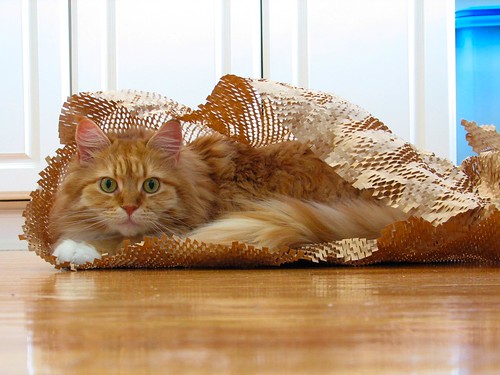- Visual Proofs
- Another good reason to use math
- Pencil is an open source 2D drawing/animation program.
- One page cookbooks for Indian food. [via]
- Minuteman I ICBM guidance computer. (photo) Beauty in the beast?
- We hope that the folks doing cool steampunk art will take start making stuff in the style of the dashboard of this 1933 Chrysler Imperial Le Baron Sport Phaeton. (Must enlarge the dashboard picture for detail.)
- Weird Bird of Paradise on YouTube (via Geek Feminism Blog)
- The skinny on spotted, striped, and ticked cats.
- I am totally putting one of these engines in my next model airplane.
- Baked cookie gyoza?
- Andromeda in the UV
- Candy Rockets: Powered by sugar, just like you.
- Floppy Mirror
- Tetris Tiles!
- Makerbeam project: a very interesting approach to open-source hardware
- Whisky Density Experiment
Some thoughts on throwies
We’re big fans of LED throwies and derivative projects where you light an LED simply by connecting it across the terminal of a small lithium coin cell.
You’ll find this trick used in a lot of our projects that call for simply lighting up an LED in a tiny space, like the temporary LED lanterns, LED Ghosties, Robogames awards,
LED origami circuitry, light-up Lego minifigures, and edge-lit holiday cards. You’ll also find them in those little keychain flashlights– open one up and there’s just a battery and an LED.
So the throwie (and I use the term loosely, referring to devices with or without magnets) is a darned useful thing. But the first time that I was introduced to the concept, I asked what a lot of other electronics-oriented people do: “where’s the resistor?”
Turns out that it’s a fair question. LEDs aren’t normally driven directly from a battery. And yet (1) people were making throwies with every imaginable color of LED and (2) they apparently weren’t exploding. So what’s the deal?
Time to get ready for Halloween
Opposition Effect
The shadow opposition effect is one of the most common optical phenomena, and once you know what it is, you might start seeing it everywhere.
Malleability versus Ductility
From the Cartoon Laws of Physics comes the following wisdom:
Cartoon Law VIII: Any violent rearrangement of feline matter is impermanent.
Cartoon cats possess even more deaths than the traditional nine lives might
comfortably afford. They can be decimated, spliced, splayed,
accordion-pleated, spindled, or disassembled, but they cannot be destroyed.
After a few moments of blinking self pity, they reinflate, elongate, snap
back, or solidify.
Corollary: A cat will assume the shape of its container.
Digi-Key sends cat toys

Ice Cream Gyoza
Gyoza, or Japanese potstickers, are not normally served with chocolate fudge sauce, but ice cream gyoza are!
Here’s how to make your own cookie dough and ice cream dessert gyoza.
Peggy goes wild
The Peggy 2 board is not small by PCB standards, but it was just not big enough for a couple of folks.
 MonsieurBon built a Giant LED Board based on the Peggy 2 circuit with a 30 x 30 display area. Here’s his photoset and video on YouTube.
MonsieurBon built a Giant LED Board based on the Peggy 2 circuit with a 30 x 30 display area. Here’s his photoset and video on YouTube.
 Dave took his Peggy 2 and mounted his LEDs off board for his u:moon project. Here’s the project page and video and photos.
Dave took his Peggy 2 and mounted his LEDs off board for his u:moon project. Here’s the project page and video and photos.
You can read about more Peggy 2 projects in our earlier story, The Peggy Strikes Back.
Remaking a portable stool
My grandfather used to make portable stools from a couple of thin pieces of wood that tied together with a simple string. Growing up we usually had a couple of these “tie stools” conveniently stashed around the house, and we always got them out for backyard barbecues and took them with us when we went camping.
Although my woodworking skills are nowhere near what my grandfather’s were, we’ve been inspired by that stool to play around with making small, lightweight furniture that can be disassembled, stacked flat and tied together for easy transport. My first try was pretty wobbly, and felt like a little twist would splinter it. A couple of revisions later, I have a reasonably sturdy stool that is held together with a nylon strap. The leg pieces are notched on the sides so that when they are stacked together, the strap on the seat piece can be used to hold all the pieces together. There are handles cut into the leg pieces as well for easy carrying.
While plywood is inexpensive and a reasonable material for prototyping, miniatures in paperboard are much faster to make and are a pretty good analog for the behavior of the wood.
More Tennis for Two
Romain saw our post on our Tennis for Two project and decided he wanted to make his own. He ordered a preprogrammed microcontroller from us and got to work. Once he was done, he was kind enough to share build photos and circuit diagrams with us.
Since he was starting with a bare CRT rather than a full scope, he built a wood and plexiglass enclosure which shows off the electronics very nicely.
We’re glad to see really retro gaming getting the attention it deserves!
















